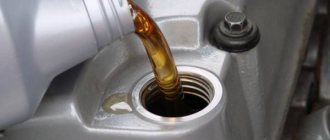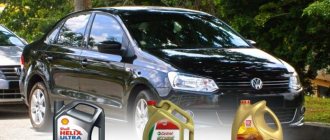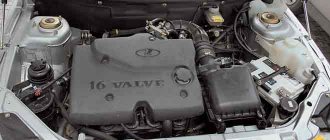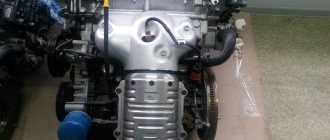When cold weather sets in, most drivers have problems starting a cold engine, since thickened lubricant does not allow the crankshaft to turn normally.
This problem depends only on the performance of the liquid that is poured into the engine, and has nothing to do with the type of engine itself (diesel or gasoline).
To avoid such a problem, in the cold season you should use winter oil that meets all the necessary viscosity requirements.
SAE oil classification
SAE is a classification of motor oils created by the American Society of Automotive Engineers. It is based on such important indicators as viscosity at low and high temperatures.
According to this classification, all motor fluids are divided by viscosity into 11 specific classes, including 5 for summer and 6 for winter.
Winter motor oil has not only a numerical designation, but also the English letter “W” - from the word Winter (winter), so it is quite easy to distinguish it from other liquids.
Winter lubricants include the following types:
- SAE 0W;
- SAE 5W;
- SAE 10W;
- SAE 15W;
- SAE 20W;
- SAE 25W.
Oils for summer time are marked as follows:
- SAE20;
- SAE30;
- SAE40;
- SAE50;
- SAE60.
In addition, another type of oil is very popular - all-season. It appeared thanks to the development of special additives that expand the operating temperature range of motor lubricants.
This type has a double digital index, which is separated by the English letter “W”.
For example: SAE 10W-30, SAE 15W-40 and so on.
All-season lubricant is a universal lubricant, as it does not lose its performance characteristics during sudden temperature changes. The properties of the all-season fluid make it possible to provide the engine with reliable protection from rapid wear at such a time.
Remember that summer oil should never be used in winter, as it does not have the required range of low operating temperatures and will not be able to provide reliable protection for your car’s engine.
ACEA marking
The ACEA standard classifies oil for each type of internal combustion engine and also determines the fluidity of the lubricant. As a rule, the higher the digital letter index, the better the quality of the oil. Today the following ACEA values are relevant:
- A/B – for gasoline and diesel engines of passenger cars. For modern engines it is better to choose A3/B4 or A5/B5
- C – for gasoline engines, as well as turbodiesels with a high degree of boost, including diesel engines with catalysts. Has the following designations: C1-04, C2-04, C3-04.
We select winter oil based on its chemical composition
All lubricants contain both natural and artificially produced components. They come down to three types:
- mineral;
- semi-synthetic;
- synthetic.
When choosing motor oil for the winter, you need to focus on what base it has.
Mineral liquid consists only of petroleum products and was widespread until the advent of all kinds of chemical components.
This type is not good enough, since it is based on a huge amount of oil-containing elements that contribute to the formation of carbon deposits in the engine. Because of this, the resource of the power unit drops significantly.
In addition, such oil should be changed at short intervals even when operating under normal conditions - 5-6 thousand kilometers. If the vehicle is used in difficult conditions, then this gap becomes even smaller.
The next type - semi-synthetics - although it consists largely of natural elements, it also contains artificially created components.
This lubricant is more resistant to temperature changes than mineral water, but significantly loses its quality at sufficiently low temperatures.
Be that as it may, the optimal oil for winter is synthetic, which has all the necessary qualities, namely:
- responds to temperature changes;
- retains its working qualities for a longer time.
The basis of this lubricant is made up of substances obtained in the laboratory. Thanks to these components, synthetics perfectly protect the engine from freezing, overheating and premature wear.
In addition, the synthetic fluid also cleans the engine, protecting it from the accumulation of dirt and carbon deposits.
ILSAC marking
ILSAC is a standard developed in collaboration with Japanese and American automobile manufacturers. This standard is in many ways similar to the API and provides for five quality categories, but we will focus on the most relevant of them:
- GF-4 - complies with API SM and is an energy-saving oil that is resistant to oxidative and corrosive processes. This lubricant has better cleaning properties compared to previous categories (GF-1, GF-2 and GF-3)
- GF-5 - complies with API SN and is suitable for the most modern engines, including highly accelerated turbo engines. One of the main indicators of this oil is the extended service interval.
Automotive manufacturers' requirements for lubricant viscosity
Viscosity is the main indicator when choosing a motor lubricant. Based on this indicator, you can always determine for yourself which oil to fill in in winter.
As you know, during the operation of the power unit, all its moving elements interact with each other. Due to heavy loads, their natural wear occurs, as well as minor deformation.
Thanks to the oil used, these processes are significantly reduced, since an oily protective film is formed on all surfaces of the parts. It also fills all the gaps between mechanical elements, but does not create significant resistance during their movement. The thickness of such a protective film directly depends on the viscosity of the oil.
You can find out what kind of lubrication your car’s engine requires from the technical documentation for the vehicle. Therefore, do not be lazy before purchasing a lubricant, read the recommendations of the manufacturer of your car.
Do not forget that oil with too high a viscosity will create difficulty turning the crankshaft when starting the engine in winter. In addition, due to its thickness, the lubricant will not be able to instantly cover all rotating parts with a protective film, which will lead to their faster wear.
But the lubricant used should not be too fluid, since it will not linger on the surface of engine parts and will drain from them, ceasing to perform a protective function.
Basic criteria for choosing winter engine oil
To quickly decide which oil is best to pour into the engine in winter, you need to take into account several important criteria:
- Operating conditions and driving style. If the car is operated in a region with a temperate climate, of the “city roads-highway” type, these conditions are considered standard. If the driver has an aggressive driving style, the car is regularly driven off-road (country roads) or used in very cold or, conversely, too hot climates, such conditions are considered to be difficult.
The role of engine condition and mileage in choosing the required lubricant
When choosing motor fluid, pay attention to the condition of the engine and the percentage of wear on its parts.
Some car enthusiasts may ask - what is this for?
And this is why it is necessary.
If you are the owner of a new car, then you will need an oil that will allow all its parts to quickly and efficiently rub against each other. This lubricant does not have a good composition for subsequent use, but is necessary at the initial stage of vehicle operation. Most often, manufacturers indicate the need to replace it after 3-4 thousand kilometers.
All subsequent oil changes, as well as recommendations for its quality composition, must be carried out in accordance with the requirements available in the technical documentation. Usually the manufacturer clearly states which oil to pour in winter and which in summer, and these requirements should be followed.
With every new hundred kilometers driven, the requirements for lubricant thickness change to some extent. This is due to the fact that natural wear of rubbing parts occurs, which no liquid can stop. As a result, the gaps between the parts increase, which must be filled with a protective layer of lubricant.
When choosing motor fluid, it is advisable to follow two simple rules:
- if your car’s mileage has crossed the line of 100 thousand kilometers, use 5W-40 lubricant in the summer, and fill in either 5W-30 or 10W in winter;
- when the mileage is more than 250 thousand, use 5W-50 in the summer, and 5W-40 or 10W in the cold season.
However, remember that these recommendations do not apply to all cars, but only to those whose manufacturer does not prohibit the use of this type of lubricant. Otherwise, you can significantly damage your car's engine.
Conclusion
If the car is new or has low mileage, then in harsh winters it is better to use 5W-30 synthetic oil, and for moderately cold climates, 5W-40 synthetic oil is better. In principle, such oils may be suitable for old used cars, but in this case, you first need to make sure that the engine does not have age-related problems (microcracks, leaks, scuffing, etc.). An alternative option is inexpensive semi-synthetic oil, which has a fairly high-quality composition that matches its price. However, semi-synthetics are more suitable for used cars.
Manufacturer's choice
The market for fuels and lubricants is simply replete with a variety of products, so it can sometimes be quite difficult to give preference to a particular company.
Let's look at some companies that have a good reputation and have been in this field for quite a long time.
The leaders include the products of the following companies:
Castrol is a high-quality lubricant that allows long-term protection of moving engine elements from wear and overheating;
Shell Helix - their products are rightfully considered one of the best, since their production is carried out using a unique technology. The quality of this lubricant, as well as its cost, is at a high level, and a large assortment allows you to select a fluid for any power unit;
Mobil - this brand can be found in any car store, as it is quite popular. All this is thanks to the high-quality composition of lubricants, which can significantly increase engine efficiency.
This is not a complete list of manufacturers that you should pay attention to when choosing winter oil for your engine.
Before the start of the cold season
It is much easier to use oils intended for all-season use, because they save the car owner from unnecessary headaches. But what if you just bought a car and don't know what kind of fluid is in it?
In this case, it is necessary to change the fuel and lubricants, and changing the engine oil should include its mandatory flushing. The previous owner may tell you that he poured high-quality fresh oil under the hood, but it’s not worth the risk. As a rule, before getting rid of an old car, people repair it not conscientiously, but within their means.
If the purchase was made before the start of the winter season, you should not neglect maintenance. It is possible that the car is filled with summer fluid, which will not allow it to be used in low-temperature conditions.
Preparing a car for winter is an important procedure, the observance of which will extend the life of the entire car. And you shouldn’t limit yourself to replacing the oil fluid. Not only car oil affects engine starting in winter.
Which oil is preferable for gasoline engines in winter?
After the first multi-grade oil appeared on sale, the line began to gradually blur when choosing fuels and lubricants for gasoline and diesel units. However, experts have not yet been able to completely get rid of this division.
Before the onset of cold weather, you should replace motor lubricant, which has used up more than half of its service life.
When choosing a lubricant, you should take into account all its characteristics that affect the engine life.
Fuel economy, noise reduction of a running engine, and starting at sub-zero temperatures also depend on motor fluid.
Therefore, select winter lubricant according to the markings on the label. The product with the most suitable viscosity and temperature range will be exactly what you need.
The most suitable universal oils:
- 0W-30;
- 5W-30;
- 5W-40;
- 10W-30;
- 10W-40.
In winter, 0W-30 lubricant will be less viscous, so starting the engine will be carried out with the least effort.
Liquid labeled 5W-30 also shows excellent results at low subzero temperatures.
All subsequent lubricants are recommended for use in regions where the winter is not too cold and the air temperature rarely drops below -5 C.
API tagging
API is an American standard that allows you to determine the compatibility of motor oil depending on the type of engine. The following letter designations are used for this:
For gasoline engines – SJ, SL, SM, SN For diesel engines – CH, CH-4, CI, CI-4, CJ, CJ-4
For modern gasoline cars, you should choose oil with API-SM or SN approval, while for diesel engines, API CJ or CJ-4 is recommended. For older cars, it is necessary to select oil with the API marking, which is closer to the beginning of the Latin alphabet. The same applies to diesel cars, and new heavy fuel engines run on oil with the latest CJ and CJ-4 approvals.
What oil to fill in a diesel engine in winter
Passenger cars and SUVs with diesel engines are a fairly popular form of transport in our country. For them, you should also choose winter oils according to viscosity, guided by the SAE standard.
For regions with low temperatures, types such as 5W-30 and 5W-40 are suitable.
It must be remembered that during the combustion of diesel fuel a lot of soot is formed, and the pressure in the combustion chambers is much higher than that of their gasoline counterparts. As a result, faster oxidation of the motor lubricant occurs and all its characteristics deteriorate, so before winter you should not leave old fluid in the engine that has completed most of its service life.
The most suitable lubricant is synthetic with a lower viscosity rating of 0W or 5W.
Make it a rule that it is best to change your engine fluid before the start of winter.
Viscosity index
An important and interesting parameter of the performance properties of an oil is its viscosity index. Let's look at it in more detail.
When a car engine is running, its temperature increases, so the viscosity of the oil decreases and it becomes thinner. The viscosity index determines how quickly the oil thins as the temperature increases. From here we get some dependence:
- The lower the viscosity index, the faster the oil becomes liquid, the thinner the oil film, and increased engine wear.
- The higher the viscosity index, the slower the oil liquefies, and the lubrication of parts improves.
In a certain sense, the viscosity index is a property that determines the stability of the oil when its temperature changes, especially to extreme values. When selecting winter oil for an engine, a higher viscosity index will ensure better engine starting in cold weather.
Motor oil manufacturers usually do not indicate the viscosity index on the packaging. Therefore, we present its value for different types of oil:
- Mineral oil – 110-135.
- Semi-synthetics – 130-150.
- Synthetics – 140-170.
Mineral oil has the lowest viscosity index. If a car with mineral oil filled with mineral oil sits all night in the cold, it is unlikely that you will be able to start the engine in the morning.
Synthetic oil has the highest viscosity index, but it is recommended for use only on new engines. If the engine has a lot of wear, then it is better to use semi-synthetic, and in some cases even mineral water will be better than expensive oil.
What to remember when operating your car in winter
First of all, you should take into account the load that the engine experiences at low temperatures. After a cold night, it should not only start normally, but also bring its temperature up to operating temperature in a fairly short period of time. In addition, temperature changes greatly affect the condition of all kinds of oil seals and seals, shortening their normal service life.
As for lubricants, this is also not easy. They are exposed to temperature changes daily from heating to rapid cooling. At this time of year, it is very important to constantly monitor the level of lubricant, which provides the necessary protection of engine elements.
How to properly prepare your car for winter?
To protect yourself from unpleasant surprises, in addition to choosing a suitable lubricant, you must do pre-winter maintenance. What does it include?
First of all, check and, if necessary, eliminate problems in the engine or injection system. Be sure to check the condition of the generator, battery and starter, which play a key role in starting the engine.
It is also necessary to check all the vehicle's technical fluids. If they have expired or are about to expire, replace them before frost sets in. This applies to both engine and transmission oils, as well as brake, coolant and power steering fluids.
NOTE!
Expired technical fluids lose their working properties, including non-freezing properties - they can become freezing! The consequence may be a rupture or depressurization of the cooling radiator, engine overhaul or, in the worst case, its replacement.
What to do before the cold weather sets in
The most important thing is to replace the old lubricant with a new one to be completely sure that it contains all the necessary performance qualities. Before adding new fluid, wash the power unit with a special detergent.
In addition, ensure that all the main components of the car that are responsible for normal starting are in proper condition.
Such systems include the generator, starter and fuel supply system.
In general, conduct a full check of your car and prepare it for the winter period.
Features of automatic transmission oil (ATF)
Most drivers, having successfully started the engine in early frost, do not think at all about the state of the “health” of the automatic transmission. But in vain! It is in cold weather that this unit most often fails. There are only two reasons:
- excessively low temperature and inappropriate oil;
- slipping on ice when leaving a place.
What happens to the automatic transmission? During operation, contaminants accumulate in the box filter. After starting the engine, it warms up successfully, which cannot be said about the “automatic”: the lubricant thickened overnight, the filter froze. As a result, oil starvation begins, lasting several minutes. When leaving a place, the automatic transmission switches on gears 2 and 3, while the pressure in the unit is insufficient, which causes the friction linings on the discs to burn. What to do?
Rules for operating automatic transmissions in winter
Start the engine and warm it up to operating temperature. Further actions:
- depress the brake pedal;
- move the automatic lever to different positions, holding each of them for 8-10 seconds;
- if the engine stalls, start it and warm it up better;
- if a slight vibration occurs, do not panic - this is normal;
- The duration of the procedure is 6-8 minutes at an ambient temperature of at least minus 20C.
You need to start moving very smoothly: squeeze the gas no more than a third of the free stroke. Move 300 meters. During this period, the oil will make several “turns” and, having warmed up, will flow to the gearshift clutches. The situation will be much simpler if your car has a special button for operating the automatic transmission in cold weather. It is usually located next to the main lever and is designated Winter, W or Snow. As soon as the program is activated, slipping will be eliminated; all transitions to higher speed will occur at minimum speed. In this case, the main load will fall on the torque converter. But do not forget to turn off the program as it gets warmer, otherwise the automatic transmission will overheat.
Some caveats. When driving on uneven surfaces, do not press on the gas, especially where there is ice. If there is slippage, the gearbox will engage in a higher gear, and if it hits the asphalt, it will engage in a lower gear. Such a constant sharp change in driving mode (which is especially typical for driving around the city) will clearly not add resource to the box.
Let's sum it up
The range of types and brands of automotive oil for winter conditions today is staggering. Among the manufacturer's offers you can find several dozen options that are suitable for your car. You should not choose oil for winter based on cost, because you may simply not start your car after a long period of parking in the cold.
It is also important to take into account the fact that if the car is stored in a heated garage, the oil requirements are significantly reduced. In this case, you can use multi-grade oil with sufficient viscosity parameters and not expose your engine to the risk of increased wear
Seasonality
It must be said that each engine will operate normally if the oil tolerance complies with the recommendations of the machine manufacturer. Professionals advise using only approved lubricants.
Viscosity by season
For example, let's take a multi-grade oil that can operate over a wide temperature range. In accordance with the technical operating conditions of the engine, it is necessary to use SAE 5W-30 lubricant all year round. It is designed for a temperature range (- 25 - +20 degrees).
With the onset of winter, SAE 0W-30 lubricant with a temperature range (-30 - +20 degrees) is suitable for such an engine. In the summer months, you can use SAE 5W-40, operating at temperatures above 35 degrees Celsius.
Another very important factor in replacing lubricating fluid is the condition of the engine and the degree of wear. In other words, the technical condition of the engine.
Drivers with extensive experience know very well that when operating a power unit, parts begin to wear out. Valve clearances increase. To compensate for the gap, reduce engine noise and extend its service life, high-viscosity oil is poured into the engine.
As a result, the operation of the lubrication system improves and normal pressure is maintained.
It is very important to follow this advice in the summer. During such months, the engine heats up to maximum temperatures.
The car often moves at high speed, developing high revs.
Change timing and oil selection
Given these features, drivers often change SAE 5W-30 lubricant after 100,000 kilometers. They start using SAE 5W-40.
For a heavily worn engine, when 50% of the planned resource has been used, it is advisable to use a more viscous oil:
- SAE 15W-40;
- SAE 20W-40.
According to the above, it is safe to say that there is no separate oil on sale intended for the summer or winter months. Therefore, the main value of all-season oils should be their viscosity, taking into account positive and negative temperature values.
Transmission oil
Finally, let's take a look at the transmission. In VAZ classic models, lubricant is poured into the gearbox and gearbox, and starting from the VAZ-2108 model and higher - only in the gearbox (they do not have a gearbox). Moreover, these units use a special oil - transmission oil. This lubricant does not require replacement as often as power plant lubricant, and the general requirements for it are much lower.
When choosing VAZ-2107 transmission oil for the winter, you don’t really need to take into account the nuances. Transmission elements use oils with SAE classification index 75W-85, 80W-90, etc. It is poured into both the gearbox and gearbox.
The same oil is used in more modern VAZ models. To more accurately select transmission oil for a particular car, it is better to find out in the operating instructions what kind of lubricant is needed.











